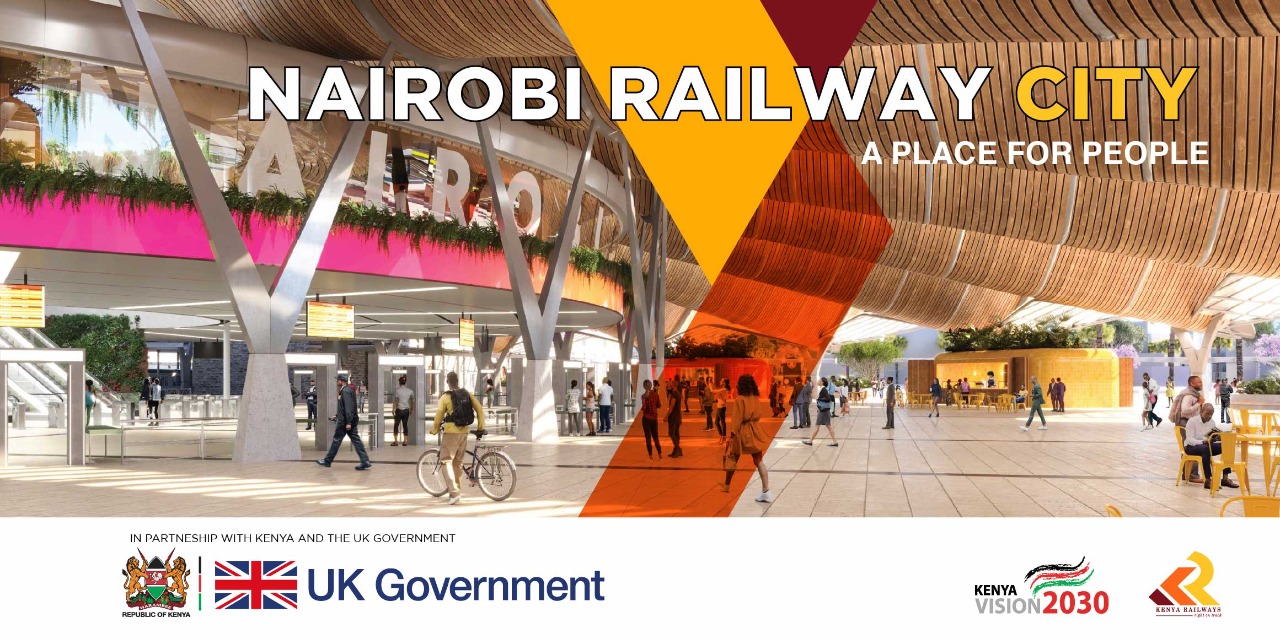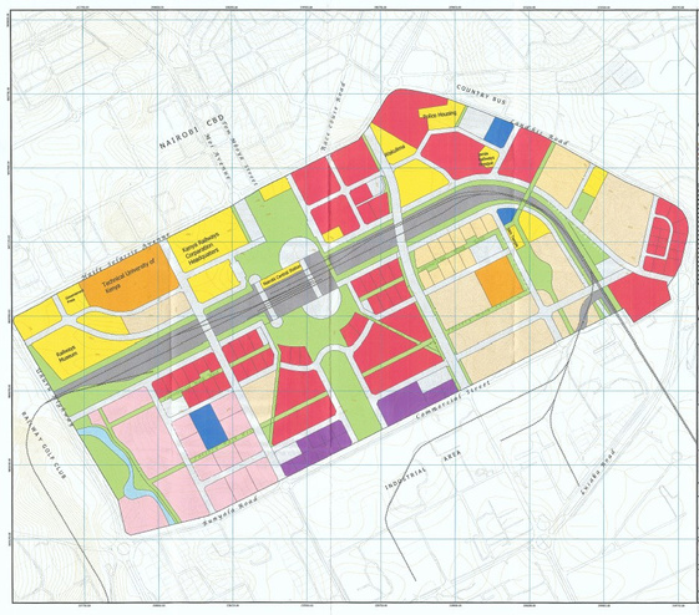
Welcome To Nairobi Railway City
Nairobi Railway City (NRC/Railway City/ the Project) is an authentically Kenyan, multimodal transit oriented urban development that seeks to establish a new beating heart for the capital and boost the economic and social development of Kenya through the realization of the project master plan.
The Project sits on 425 acres of prime underutilized land within the Central Business District (CBD) of Nairobi. A vast majority of this land is owned by Kenya Railways, Kenya Railways Staff Retirement Benefit Scheme (KRSRBS) and other Government Agencies.
In maintaining the theme of what is authentically Nairobi, Railway City has heavily promoted the following themes within the development:
- Full alignment with the Nairobi Integrated Urban Master Plan (NIUPLAN), Nairobi Transport Master Plan, and Nairobi Commuter Rail Master Plan which ensures seamless integration with the greater plans for Nairobi.
- Non-Motorised Transport corridors in every precinct of the development allowing for easy movement of pedestrians, who make up a majority of Nairobi residents.
- Seamless integration with public transport nodes throughout the development. Railway City has an expanded Central Station, new Bus Rapid Transit (BRT) lines and stations as well as revamped matatu termini that will allow Nairobians clear transit pathways.
- An all-inclusive development that ensures Nairobians of all walks of life a means to carry out business, live and enjoy the wellness and recreation centres. Railway City will be the new meeting place for Nairobians and a beacon of prosperity for the nation at large.
Project Objectives
Railway City is looking to achieve four key objectives:
Hub
A new Central Station Hub as Nairobi’s premier interchange – creating the best-connected location within the City and additional ridership and revenue for Kenya Railways.
Employment
5,000 jobs will be created during the construction of Phase 1 and 2 with a further 5,000 jobs created once first two phases are complete. There will be numerous opportunities for Micro and
Small Medium Enterprises (MSMEs) to carry out trade within the newly established retail and commercial spaces in the public realm and Non Motorised Transport (NMT) corridors.
Enabling Ecosystem
A surrounding development which will, over time, provide:
- New meeting places
- New business districts for government and companies
- New neighbourhoods for family living
- New open spaces for recreation and wellness
- Low-carbon buildings of medium density, high amenity and high accessibility to public
Sustainability
Establishing a place which is sustainable and safe, forward-looking & authentically Kenyan.
The Nairobi Railway City Strategic National Installation and Project Plan (2023-2033)
Kenya Railways in conjunction with the Ministry of Roads and Transport, the Ministry of Lands, Public Works, Housing and Urban Development and the Nairobi City County Government (NCCG) prepared a plan for the Nairobi Railway City. The project was proposed as one of the priority projects in the Nairobi Integrated Urban Development Masterplan (NIUPLAN), 2014, as a strategy to expand Nairobi’s Central Business District and the regeneration of Nairobi City thereby plugging into the objectives of Kenya Vision 2030.
Nairobi Railway City is gazetted as a Project of Strategic National Importance in Gazette Notice No. 4710 dated 21st May 2021, pursuant to provisions of Legal Notice No. 156 of the Physical and Land Use Planning (Classification of Strategic National on Inter County Projects) Regulations , 2019.
Consequent to this classification, the statutory responsibility for the Physical and Land Use Planning activities for the entire Nairobi Railway City lies solely with the Director Physical Planning while all development control activities within the jurisdiction of the Nairobi Railway City is under the sole authority of the Cabinet Secretary responsible for Physical Planning Matters, as provided for under the provisions of section 13(g) and 69 (4) of the Physical and Land Use Planning Act, 2019, respectively.
Concept design
 This design was developed in line with industry best practice and guidelines and in line with the
This design was developed in line with industry best practice and guidelines and in line with the
project brief highlighted below:
- Iconic, landmark design with distinctive façades and roof structure that is intimately reflective of Nairobi’s heritage and that of Kenya at-large.
- Incorporate existing heritage station
- 2-storey building – Ground floor to be retail/F&B and other amenities – capable of being used by passengers and occupiers of surrounding buildings. First floor to provide ticket hall and access to platforms
- Provision for future entrance on south side of platforms
- Landscaped, grand landmark public square in front.
- A design compliant with low carbon and climate resilient design principles including efficiency, build-ability, embodies carbon, carbon in use, maintenance, and whole life costs
- A design that consider the opportunities that arise from the stations interface between the railway station and the local community.
- Imaginative solutions that deliver a stress- less experience that enhance the social
value of the station and its surroundings. - Designs that are flexible and adaptable to changes in behaviour, future technical requirements, and rapidly evolving technologies.
- A design that shows how energy and operational maintenance.
- Consideration for the use of durable the materials over the lifespan of the building to
weather and how it matures with age costs will be optimised through the design
UK Government support
Kenya and the UK have a long history relating to railway development, with the UK Government having constructed Kenya’s first railway network in the 1890s.
The UK Government is keen to partner with African countries as part of its mission to become Africa’s investment partner of choice.
At the UK-Africa Investment Summit, held in London on 20th January 2020, the former president of the Republic of Kenya his Excellency President Uhuru Kenyatta, and the former British Prime Minister, Boris Johnson met and discussed the Nairobi Railway City Project. On the back of that discussion Prime Minister Johnson offered Kenya UK Government support to help Kenya take forward the project.
Since early 2020 the UK Government has funded a team of urban development experts to provide relevant Kenyan government agencies involved in taking forward NRC with technical support that has included a review of the master plan, land due diligence, identification of priority projects, a feasibility study and detailed design and associated engineering and costing of the first priority project, a new central Railway Station at the Centre of Nairobi City Centre.
Furthermore, the UK Government through UK Export Finance (UKEF) have signed an MoU with Kenya’s National Treasury and Planning to finance infrastructure projects in Kenya. Railway City is the first mover project under this MoU upon which financing will be unlocked for other
infrastructure projects.
Railway City continues to be an important project in the UK’s strategic partnership with the Government of Kenya and as such continues to enjoy high level political support from both governments.
Central Station & Public Realm

The new Nairobi Central Station and adjacent public realm will be the iconic centrepiece of a new Railway City and the focal point of Nairobi’s new multimodal urban transportation network. The Central Station’s landmark design incorporates the existing stations heritage in a new design that links to and integrates with the new Bus Rapid Transit Project.
Kenya Railways seeks to develop a unique, state of the art railway station that will increase the stations capacity to cope with a rapidly expanding commuter network. The station will provide seamless interconnectivity with the City through Non-Motorized Transport (NMT) corridors and other integrated transit nodes such as the BUS Rapid Transit (BRT) project.
The intended outcome is a safe and secure environment at the station for everyone.
The Central Station incorporates low carbon and climate resilient design principles including efficiency, buildability, use of durable materials and considers whole life costs. The development is influenced by Nairobi’s climate and actively engages the public to create a fresh, responsible space for all Nairobian’s.


